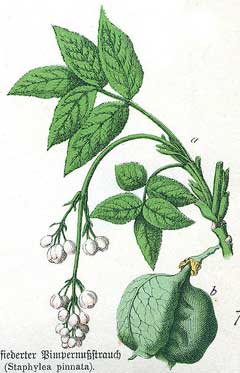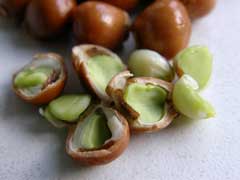 |
|
http://commons.wikimedia.org/wiki/File:Staphilea-pinnata-Naturgesc.jpg |
 |
|
Translate this page:
Summary
Physical Characteristics

 staphylea pinnata is a deciduous Shrub growing to 4.5 m (14ft) by 4.5 m (14ft).
staphylea pinnata is a deciduous Shrub growing to 4.5 m (14ft) by 4.5 m (14ft).
See above for USDA hardiness. It is hardy to UK zone 6. It is in flower from May to June, and the seeds ripen from September to November. The species is hermaphrodite (has both male and female organs) and is pollinated by Flies.
Suitable for: light (sandy), medium (loamy) and heavy (clay) soils. Suitable pH: mildly acid, neutral and basic (mildly alkaline) soils. It can grow in semi-shade (light woodland) or no shade. It prefers moist soil.
UK Hardiness Map
US Hardiness Map
Synonyms
Plant Habitats
Woodland Garden Sunny Edge; Dappled Shade; Shady Edge;
Edible Uses
Edible Parts: Seed
Edible Uses:
Seed - raw[2, 105, 177]. Said to taste like pistachios, the seeds are eaten by children in Germany[183].
References More on Edible Uses
Medicinal Uses
Plants For A Future can not take any responsibility for any adverse effects from the use of plants. Always seek advice from a professional before using a plant medicinally.
None known
References More on Medicinal Uses
The Bookshop: Edible Plant Books
Our Latest books on Perennial Plants For Food Forests and Permaculture Gardens in paperback or digital formats.

Edible Tropical Plants
Food Forest Plants for Hotter Conditions: 250+ Plants For Tropical Food Forests & Permaculture Gardens.
More

Edible Temperate Plants
Plants for Your Food Forest: 500 Plants for Temperate Food Forests & Permaculture Gardens.
More

More Books
PFAF have eight books available in paperback and digital formats. Browse the shop for more information.
Shop Now
Other Uses
References More on Other Uses
Cultivation details
Tolerant of a wide range of soils so long as they are not too dry[11, 182, 200], it prefers a rich loamy soil in full sun or semi-shade[200]. Prefers a neutral to acid soil but tolerates some alkalinity[202]. A very ornamental plant[1], it is hardy to about -20°c[184]. The plants flower best in years that follow hot summers[200]. Plants in this genus are notably resistant to honey fungus[200].
References Carbon Farming Information and Carbon Sequestration Information
Temperature Converter
Type a value in the Celsius field to convert the value to Fahrenheit:
Fahrenheit:
The PFAF Bookshop
Plants For A Future have a number of books available in paperback and digital form. Book titles include Edible Plants, Edible Perennials, Edible Trees,Edible Shrubs, Woodland Gardening, and Temperate Food Forest Plants. Our new book is Food Forest Plants For Hotter Conditions (Tropical and Sub-Tropical).
Shop Now
Plant Propagation
Seed - this can be very slow to germinate, sometimes taking 18 months or more. It is best sown as soon as it is ripe in a cold frame[200], and some of it at least should then germinate in the spring. Stored seed should be sown as early in the year as possible and given cold stratification - it might not germinate until spring of the following year. Prick out the seedlings into individual pots when they are large enough to handle and grow them on in light shade in the greenhouse for their first winter. Plant them out early the following summer. Cuttings of half-ripe wood, 5 - 8cm with a heel, July/August in a frame. Fair to good percentage[78]. Layering in July/August. Takes 15 months. Good percentage[78]. Plants sometimes produce suckers, these can be removed in the dormant season and planted out.
Other Names
If available other names are mentioned here
Klokocs, Nezcoupe,
Native Range
TEMPERATE ASIA: Turkey, Russian Federation-Ciscaucasia (Ciscaucasia), Azerbaijan, Georgia EUROPE: Czechoslovakia, Austria, Switzerland, Germany, Hungary, Poland, Russian Federation (European part), Former Yugoslavia, Bulgaria, Italy, Romania, France
Weed Potential
Right plant wrong place. We are currently updating this section.
Please note that a plant may be invasive in one area but may not in your area so it's worth checking.
Conservation Status
IUCN Red List of Threatened Plants Status :

Growth: S = slow M = medium F = fast. Soil: L = light (sandy) M = medium H = heavy (clay). pH: A = acid N = neutral B = basic (alkaline). Shade: F = full shade S = semi-shade N = no shade. Moisture: D = dry M = Moist We = wet Wa = water.
Now available:
Food Forest Plants for Mediterranean Conditions
350+ Perennial Plants For Mediterranean and Drier Food Forests and Permaculture Gardens.
[Paperback and eBook]
This is the third in Plants For A Future's series of plant guides for food forests tailored to
specific climate zones. Following volumes on temperate and tropical ecosystems, this book focuses
on species suited to Mediterranean conditions—regions with hot, dry summers and cool, wet winters,
often facing the added challenge of climate change.
Read More
Expert comment
Author
L.
Botanical References
11200
Links / References
For a list of references used on this page please go here
Readers comment